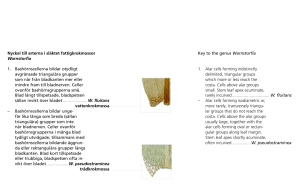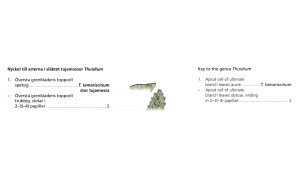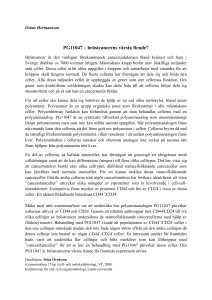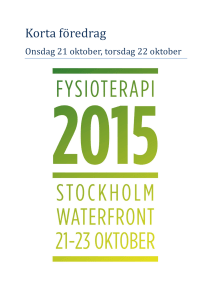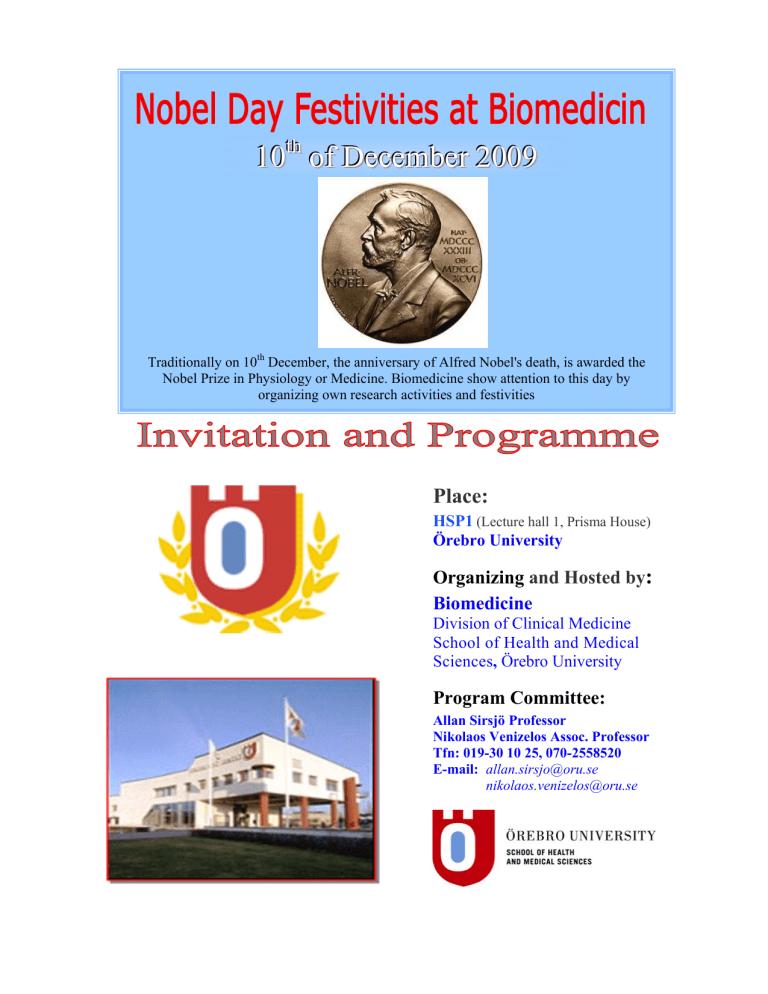
10tthh of December 2009
Traditionally on 10th December, the anniversary of Alfred Nobel's death, is awarded the
Nobel Prize in Physiology or Medicine. Biomedicine show attention to this day by
organizing own research activities and festivities
Place:
HSP1 (Lecture hall 1, Prisma House)
Örebro University
Organizing and Hosted by:
Biomedicine
Division of Clinical Medicine
School of Health and Medical
Sciences, Örebro University
Program Committee:
Allan Sirsjö Professor
Nikolaos Venizelos Assoc. Professor
Tfn: 019-30 10 25, 070-2558520
E-mail: allan.sirsjo@oru.se
nikolaos.venizelos@oru.se
2
PPR
RO
OG
GR
RA
AM
MM
ME
E
TThhuurrssddaayy,, 1100 ooff D
Deecceem
mbbeerr 22000099
LLeeccttuurree hhaallll H
HSSPP11
Time
15.30-16.00
Set up time for Posters:
Place: Main entrance hall 2nd floor, Prisma House
Allan Sirsjö
16.00-16.05
Welcome
16.00-17.00
Nobel Days Lecture:
Nikolaos Venizelos
Fredrik H. Nystrom
MD, PhD, professor,
Fast food based hyper-alimentation induces insulin
resistance but elevates muscle mass and HDL cholesterol
17.00-17.15
Speaker
Department of Medical and
Health Sciences, Faculty of
Health Sciences, University
Hospital of Linköping
Coffee Break
PhD presentations:
17.15-17.30
Role and expression of CYP26 in the vasculatur.
Ali Ateia Elmabsout
17.30-17.45
Prevalence of HTLV ½-infection in Sweden.
Kerstin Malm
17.45-18.00
Loss of mitochondrial solute carrier SLC25A43- a
Breezy Paul
common event in HER2 positive breast cancer.
18.00-18.15
Phenotypical and functional characteristic of T cells Ashok Kumar
in microscopic colitis.
Kumawat
18.15-19.15
Poster presentations:
See Abstracts list
19.15-
Nobel Days Dinner, Foyer Hall 2nd Floor Prisma
House
See Menu
LIST OF PARTICIPANTS
Name
Kerstin Malm
Shahida Hussain
Johanna Sundin
Johanna Lönn
Christina Karlsson
Berolla Sahdo
Pia Wegman
Elisabeth Hultgren-Hörnqvis
Jessica Johansson
Gunilla Lundberg
Ashok Kumar Kumawat
Sten Wigren
Rashida Hussain
Eva Särndahl
Marike Gabrielson
Godfried Roomans
Breezy Paul
Anita Hurtig Wennlöf
Anna Göthlin-Eremo
Allan Sirsjö
Ali Elmabsout
Nikolaos Venizelos
Christer Larsson
Kristina Elgbratt
3
LIST OF ABSTRACTS
POSTER 1
Interleukin-1beta inhibits tyrosine transport in fibroblasts from schizophrenic
patients and healthy controls
J. Johansson, R. Vumma, N. Venizelos
Neuropsychiatric Research Laboratory, Department of Clinical Medicine, School of Health and Medical
Sciences, Örebro University, Örebro, Sweden
Objective: A repeated finding in schizophrenic patients is an aberrant tyrosine transport, shown in
fibroblast cell model by our group and others. Altered levels of the pro-inflammatory cytokine interleukin1beta (IL-1β) are indicated in schizophrenic patients and IL-1β has shown to have inhibitory effect on
amino acid transport systems. Based on these findings, the aims of this study were to examine the effect of
IL-1β on tyrosine uptake in fibroblasts of schizophrenic patients and healthy controls and to study any
difference in tyrosine uptake between patients and controls.
Method: Fibroblast cells were incubated with different concentrations (0.01 ng/ml to 10 ng/ml) of IL-1β for
different time periods (1 hour to 24 hours) to optimise the effect of IL-1β on tyrosine uptake. The optimised
conditions were used to study the difference in tyrosine uptake between patients and controls. Fibroblast
cell lines from schizophrenic patients (n=10) and healthy controls (n=10) were treated with 5 ng/ml of IL1β for 6 hours. Fibroblasts untreated with IL-1β were used as controls in all studies. Uptake of 14C (U)-Ltyrosine was measured using the cluster tray method.
Results: IL-1β significantly inhibited the tyrosine uptake in fibroblasts from patients with schizophrenia by
43 % (p < 0.001) and healthy controls by 42 % (p < 0.001). The inhibition of tyrosine uptake by IL-1β was
abolished in the presence of IL-1 β receptor antagonist. No difference in uptake levels between fibroblasts
of schizophrenic patients and controls was found.
Conclusions: This study demonstrated that the pro-inflammatory cytokine IL-1β have a strong inhibitory
effect on tyrosine transport systems, which indicates that increased levels of IL-1β in schizophrenic patients
can be a factor of importance in the availability of tyrosine. As tyrosine is the precursor for the monoamines
dopamine and noradrenaline and since the brain is the only organ for which amino acid transport is limited,
a limited transport of tyrosine caused by IL-β could lead to disturbances in dopamine and noradrenaline
metabolism. Further studies are needed to elucidate the transport aberration and the significance of these
findings.
POSTER 2
Prevalence of HTLV 1/2-infection in Sweden
Kerstin Malm1, Bengt Ekermo 2 and Sören Andersson 3
1
Department of Laboratory Medicine, Örebro University Hospital; Örebro, Sweden
Department of Transfusion Medicine, Linköping University Hospital, Linköping, Sweden
2
3
Department of Virology, Swedish Institute for Infectious Disease Control, Stockholm, Sweden
Background and objective: Prevalence data on HTLV-1/2 in Sweden have not been updated since 1995
when mandatory screening of new blood donors was introduced. The seroprevalence among blood donors at
that time was 0.2/10000. A few years earlier, a high prevalence of HTLV-2 was found in intravenous drug
users (ivdus) in Stockholm, Sweden (3.4%). In 2003 mandatory screening of couples preparing for in vitro
4
fertilization (IVF) was initiated in Sweden. The objective of this study was to update information on
seroprevalence of HTLV in these groups.
Methods: Serum samples from pregnant women in Örebro county, during the years 1995, 1998, 2000 and
2003 (n=11 997) were investigated for HTLV-1/2 antibodies. We also included 355 samples from anti-HCV
positive individuals, representing a risk group for blood borne infections outside the greater urban areas.
Serum samples from intravenous drug users in Stockholm, were also collected and analysed (n= 1079).
Data from the mandatory HTLV-1/2 screening (2003-2006) on patients attending clinics for in-vitro
fertilization were compiled, as well as data from new blood donors.
Results: Among 11 997 tested pregnant women, no anti-HTLV-1/2 positive individual was found. Eight of
the 40 000 investigated IVF-patients were anti-HTLV-1/2 positive (2 HTLV-1, 1 HTLV-2, 5 untyped;
seroprevalence 2.3 per 10 000). Of the anti-HCV – positive individuals (n=355) one sample was HTLV-1 –
positive (28.2 per 10 000). During the years 1995-2007, 18 HTLV-positive new blood donors were found
(16 HTLV-1, 2 HTLV-2), out of approximatively 550 000 individuals tested (0.3 per 10 000). 37 of 1079
tested ivdus were screening reactive. Typing shows that a majority of these are HTLV-2.
Conclusion: The seroprevalence among Swedish IVF patients is ten times higher than among blood donors.
This is comparable to a European seroprevalence study among pregnant women made in 2003, in seven
countries. However, it cannot be ruled out that the IVF group includes individuals with a higher risk of
acquiring STIs including HTLV, than the general population. Among known risk group persons, the
seroprevalence was substantially higher than the other groups studied. HTLV-2 appears to still be prevalent
among Swedish ivdus.
POSTER 3
Reduced expression of mitochondrial solute carrier SLC25A43 helps breast
cancer cells escape apoptosis.
Marike Gabrielson, (PhD-student)
Hälsoakademin, Breast Cancer Research Group, Klinisk Forsknings Centrum,USÖ
During the past decade, the role of mitochondria as a key regulator of cell survival and apoptosis has
become clearer. Alongside, the involvement of an altered energy metabolism in mitochondria of developing
malignant cells is currently being argued as an addition to the to the list of cancer hallmarks. The solute
carrier protein family 25 (SLC25) has 46 known members, and is involved in the transportation of
molecules across the mitochondrial membrane. The transported molecules, such as ADP/ATP and CoA are
crucial regulators of various essential functions within the cell. Little is known about SLC25A43. Here we
present novel information revealing the involvement of SLC25 member A43 in regulating survival of
normal and breast cancer cells In Vitro. We show that the SLC25A43 gene is expressed at a 14-fold lower
concentration in the breast cancer BT474 cell line compared to normal MCF10A epithelial breast cells. In
both cell types, the SLC25A43 gene expression increases over time corresponding to the proliferation rate
of the cells. siRNA targeting SLC25A43 in MCF10A and BT474 cells resulted in a 91% and 82% mRNA
reduction respectively. Inhibition of the gene also induced extensive necrosis in MCF10A cells, whereas no
significant necrosis was observed in the cancer cells. We show here, for the first time, that the
mitochondrial solute carrier gene SLC25A43 is involved in the growth and survival of normal breast
epithelial cells. An extensively reduced expression of the gene in breast cancer cells BT474 along with
continued growth upon gene silencing, indicates an alteration of the mitochondrial functions in the
carcinogenic cells. Further investigations have to be conducted in order to identify the specific mechanisms
regulated by SLC25A43, both in normal and cancer cells.
5
POSTER 4
CYP26B1 plays a major role in the regulation of all-trans retinoic acid
metabolism in human aortic smooth muscle cells (AOSMCs).
Ali Ateia Elmabsout1 ,Pauline Ajok Ocaya 1, Peder Stefan Olofsson2, Hans Törmä 3 , Andreas Carl Gidlöf 2
and Allan Sirsjö 1
1
Division of Biomedicine, Department of Clinical medicine, Örebro University, Örebro, Sweden, 2Center
for Molecular Medicine, Department of Anesthesiology and Intensive Care Medicine, Karolinska University
Hospital, Karolinska Institutet, Stockholm, Sweden, 3Department of Medical Sciences/Dermatology,
Uppsala University, Uppsala, Sweden.
Aim: The cytochrome P450 enzymes of the CYP26 family are involved in the catabolism of the
biologically active retinoid, all-trans-retinoic acid (atRA). Since it would be possible that an increased local
CYP26 activity may reduce the effects of retinoids in vascular injury, we investigated the role of CYP26 in
the regulation of atRA levels in human aortic smooth muscle cells (AOSMCs).
Methods: The expression of CYP26 was investigated in cultured AOSMC using real time PCR. The
metabolism of atRA was analyzed by HPLC and R115866 or siRNA was used to suppress cyp26
activity/expression
Results: We found that AOSMCs expressed CYP26B1 constitutively and atRA exposure augmented
CYP26B1 mRNA levels. Silencing of CYP26B1 gene expression or reduction of CYP26B1 enzymatic
activity by using the inhibitor R115866 increased atRA mediated signalling and resulted in decreased cell
proliferation. The CYP26 inhibitor also induced expression of atRA-responsive genes. Therefore, atRAinduced CYP26 expression accelerates atRA inactivation in AOSMCs, giving rise to an atRA-CYP26 feedback loop. Inhibition of this loop with a CYP26 inhibitor increases retinoid signalling.
Conclusion: The results indicate that CYP26 inhibitors may be a therapeutic alternative to exogenous
retinoid administration.
POSTER 5
STAPHYLOCOCCUS AUREUS TOXINER AKTIVERAR INFLAMMASOMEN I HUMANA NEUTROFILA
GRANULOCYTER
Berolla Sahdo 1, Bo Söderquist 2 och Eva Särndahl 1
1
2
Avdelningen för Klinisk Medicin, Örebro Universitet
Avdelningen för Laboratoriemedicin, Mikrobiologi, Universitetssjukhuset Örebro
Staphylococcus aureus är en välkänd patogen som kan orsaka allt från banala till livshotande
blodförgiftning eller inflammation i hjärtats klaffar. Vi vet inte varför vissa personer drabbas av svåra
infektioner med hög dödlighet, medan andra uppvisar lindriga sjukdomssymptom. En kombination av
bakteriens sjukdomsframkallande faktorer och varje individs unika immunförsvar är det man idag tror avgör
sjukdomens svårighetsgrad. En förståelse av kroppens mekanismer under en infektion är därför nödvändig
för att i framtiden kunna hindra svåra bakteriella infektioner i synnerhet med det ökade hotet från
antibiotika resistenta bakterier. Kunskapen om den inflammatoriska processen vid infektioner har ökat
genom upptäckten av intracellulära receptorer, Nod-like-receptors (NLR), som vid aktivering av bl a
komponenter från bakterier bildar multi-proteinkomplex som kallas inflammasomer. Inflammasomen
6
aktiverar caspase-1 som i sin tur klyver prointerleukin-1 (proIL-1 ) till sin aktiva form. IL-1
kroppens mest potenta pro-inflammatoiska cytokin och ger upphov till feber och leukocytos.
är
Staphylococcus aureus producerar ett stort antal toxiner och enzymer som tros vara orsaken till det breda
spektrum av olika infektioner denna bakterie orsakar. Denna studie undersöker två olika toxiner ( -toxin
och PVL-toxin). -toxin och PVL bildar porer i cellerna, men man vet inte vilka mekanismer som ligger
bakom ett påverkat inflammatoriskt svar.
Aktivt caspase-1 detekteras i humana neutrofila granulocyter med hjälp av av FLICA som är en
flourescentmärkt inhibitor vilket analyseras via flödescytometri. Preliminära resultat visar att
bakteriestammar som producerar stor mängd av -toxin respektive PVL-toxin ger en aktivering av caspase1. Dessa resultat indikerar att S. aureus aktiverar ett inflammatoriskt svar genom att de por-formande
toxinerna aktiverar inflammasomer.
POSTER 6
Wwox expression in breast cancer tissue from patients treated with or without
tamoxifen
Anna Göthlin-Eremo, Pia Palmebäck Wegman, Sten Wingren
Hälsoakademin, Breast Cancer Research Group, Klinisk Forsknings Centrum,USÖ
Background: A positive estrogen (ER) and progesterone (PgR) status is regarded as a good indicator for
outcome of breast cancer considering that these tumors are candidates for endocrine therapy such as
tamoxifen. Unfortunately close to 30 % fail to respond and 40 % of initial responders develop resistance
towards tamoxifen. Reliable markers for treatment outcome are yet to be discovered which is of substantial
clinical relevance given that resistant patients are in risk of relapse from disease. The gene coding for the
WW domain-containing oxidoreductase protein (WWOX, FOR) is located at a genomic fragile site
(FRA16D) where loss of heterozygosity and hypermethylation, resulting in WWOX inactivation, has been
reported in several types of cancer. Wwox participates in cellular processes such as growth, apoptosis and
tumor suppression (Del Mare et al 2009). Reduced or absent expression of Wwox is associated with
tamoxifen resistance and ER status in breast cancer according to a study by Guler et al (2007). Also, Wwox
seem to have an important, but still left to be fully elucidated, role in hormonally influented tissue and can
interact with several proteins of interest such as p53 and HER4.
Objective: In our study, we aimed to investigate the relationship between Wwox and outcome of breast
cancer in breast tissue from patients randomized to treatment or no treatment with tamoxifen.
Method: We used immunohistochemistry on tissue micro arrays (TMA) from paraffin-embedded breast
material from 912 cancer patients. The results were evaluated in a microscope.
Preliminary results: Patients treated with tamoxifen who had a moderate/high cytoplasmic staining of
Wwox had a significantly (p=0,01) improved recurrance free survival compared to those with a weak or
negative staining. For untreated patients there was no difference in outcome depending on grade of staining
(p=0,56). Tamoxifen treated patients with Wwox signal in nuclei had a greatly improved survival (p=0,002)
compared to patients without nuclear staining. In patients with no tamoxifen treatment, there was no
difference in survival regarding nuclear staining of Wwox (p=0,67).
Conclusion: As suggested, Wwox seem to play a role in the cellular responce to tamoxifen and possibly
resistance mechanisms. Preliminary results show that higher Wwox expression is correlated to a better
survival in tamoxifen treated breast cancer patients. Future studies will hopefully give more insights of the
importance of Wwox in breast cancer.
7
POSTER 7
Phenotypical and functional characteristics of T cells in Microscopic Colitis
Ashok Kumar Kumawat
DEPARTMENT OF CLINICAL MEDICINE, SCHOOL OF HEALTH AND MEDICAL SCIENCES, ÖREBRO
UNIVERSITY
Background
The intestinal immune system, which is the largest and most complex immune compartment of the entire
body, plays a major role by responding to harmful pathogens while tolerating dietary antigens and
beneficial bacteria. It employs several strategies to maintain its’ homeostatic balance. Dysregulated immune
responses in the intestine can lead to chronic inflammatory diseases such as inflammatory bowel disease
(IBD), [comprising Crohn’s disease (CD) and Ulcerative colitis (UC)], and microscopic colitis (MC). MC is
a more recently discovered form of colonic inflammation previously regarded rare, but with an incidence
roughly the same as for UC. The name originates from the fact that the colonic mucosa is macroscopically
normal whereas microscopic examination of biopsies reveals distinct histopathology. MC comprises two
conditions, collagenous colitis (CC) and lymphocytic colitis (LC). Both diseases present increased densities
of lymphocytes and plasma cells in the mucosa, whereas CC also has a thickened subepithelial collagen
band. MC tends to affect the middle-aged population, the peak incidence is around 60-65 yr of age and the
majority of them are women, often associated with other autoimmune disorders such as celiac disease,
thyroid disorder, diabetes and arthritis. The prevalence of MC is 4-5% in general population and 7-14% in
the elderly population. MC is multifactorial and mostly unknown. The overall goal of this project is to
investigate the role of immunoregulatory dysfunctions in the gastrointestinal mucosa in the etiology and
pathogenesis of MC.
Figure 1. Microscopic colitis.
Nielsen O H et al. (2008), Nat Clin Pract Gastroenterol
Hepatol
(A) Photomicrograph of colonic mucosa with collagenous colitis. A thickened layer of collagen is formed beneath the
surface epithelium (arrows). Tenascin is incorporated into the collagen, which can be used to distinguish this layer
from the normal basement membrane (hematoxylin and eosin stain, magnification 200). (B) Photomicrograph of
lymphocytic colitis showing the inflamed colonic mucosa infiltrated with considerable numbers of cytotoxic
lymphocytes in the epithelium. In this case, more than 40% of the cells in the epithelial layer are lymphocytes. The
leukocytes infiltrating the lamina propria include a mixture of lymphocytes, plasma cells, macrophages, eosinophilic
granulocytes, and, occasionally neutrophils (hematoxylin and eosin stain, magnification 200).
Material
Biopsies from MC and IBD patients as well as from healthy individuals are being provided by colleagues at
the Dept of Gastroenterology, Örebro University Hospital, Örebro. As IBD is well characterized at the
pathophysiological level, these patients will be used as positive controls.
8
Research Plan
We are performing a detailed flow cytometric characterization of the intraepithelial lymphocytes (IELs) and
lamina propria lymphocytes (LPLs) isolated from mucosal biopsies from MC and IBD patients.
We will also perform an initial screening of a large number of immune related genes using gene PCR array
analysis on the biopsies. Following the phenotypic delineation, the isolated lymphocytes will be activated
with monoclonal antibodies (anti-CD3, 2, 28) and will be investigated for cytokine production using the
Luminex or ELISA.
Based on the flow cytometric and RT-PCR results, we will perform immunohistochemistry of key markers
on mucosal biopsies collected from MC patients. With these studies we hope to shed further light on
pathophysiology of MC. Significantly, new avenues for immune based differential diagnosis and treatment
of MC will be opened.
POSTER 8
STEROID HORMONE RECEPTORS IN NON-SMALL CELL LUNG CARCINOMAS
Christina Karlsson1, Oswaldo Fernandes2 & Mats G Karlsson1,3.
School of Health and Medical Sciences1, Örebro University and Depts of Thoracic surgery2 and
Pathology3, Örebro University Hospital, Sweden.
Background
Steroid hormone receptors have been studied in non-small cell lung carcinomas (NSCLC) in the perspective
of gender-associated differences in tumour types and prognosis. During recent years receptor subtypes for
both oestrogen (ER/ER) and progesterone (PRA/PRB) have been identified and conflicting results
concerning their expression have been reported.
Methods
A consecutive material of 270 NSCLC surgically treated at Örebro University hospital between 1990 and
1995 has been studied. The tumours consisted of 126 squamous cell carcinomas (SCC), 140
adenocarcinomas (ADCA), 3 adenosquamous carcinomas and one large cell carcinoma. 172 of the patients
were males and 98 females. Immunohistochemistry was performed, including heat epitope antigen retrieval,
with monoclonal antibodies to ER, ER, PRA and PRB using Envision visualization procedure. Nuclear
positivity was scored positive when > 10% of tumours cells were stained.
Results
ER expression was focally present in 4 adenocarcinomas.
ER was present in 63 tumours. ER expression was more frequent in SCC, 29%, then in adenocarcinomas,
19%, p=0.04 (Pearson chi2-test).
The differences between histological types could be seen in the male group (p 0.03) while it failed to reach
statistical significance amongst women. Overall, female tumours were ER positive in 28% whilst male
tumours in 21%, (ns, chi2-test). There was no difference concerning mean age between ER groups in either
gender.
None of the tumours expressed PRA or PRB.
Discussion
Taking our and previously published data into consideration, discrepancies in ER expressions seems to be
antibody dependent. Our data supports that only a very small fraction of NSCLC expresses ER. The
absence of PR expression is in concordance with the absence of functional ER signalling.
ER expression occurs frequently with a slight predominance in SCC compared to ADCA, without
influence of gender. Whether ER mediated effects occurs in NSCLC remains to be studied.
9
POSTER 9
Loss of mitochondrial solute carrier SLC25A43- a common event in HER2
positive breast cancer
Breezy Malakkaran,
Hälsoakademin, Breast Cancer Research Group, Klinisk Forsknings Centrum,USÖ
Mitochondria have been traditionally considered as the “Powerhouse” of the cell. In 1926, Otto Warburg
observed that cancer cells depend on aerobic glycolysis instead of oxidative phosphorylation for ATP and
suggested aberrant mitochondria as a key factor in carcinogenesis. Since then this role of mitochonria is
being explored.
Deletion of SLC25A43 ( a mitochondrial solute carrier), was discovered in 80% (20 of 25) of HER 2
positive breast cancer (BCA) cases by whole genome SNP array (Affymetrix GeneChip Human Mapping
250K® Nsp1). LOH (loss of heterozygosity) analysis using AB1 3130xl Genetic Analyzer revealed that 45%
(5 of 11) harboured allelic imbalance (AI). Similar result was also found in a larger cohort of HER2
positive BCA (51%, 14/27), HER2 negative BCA (13%, 3 of 22), cervical cancer (46%, 12 of 26 ) and lung
cancer (23%, 3 of 13). Mutation analysis on all 6 exons of SLC25A43 gene by SSCP (Single-strand
Conformation Polymorphism) and Sanger chain termination DNA sequencing, revealed a single mutation in
exon 1 in one of the cases.
The mitochondrial solute carriers (SLC) are almost always localized in the inner mitochondrial memebrane
and provide a link between cytosol and mitochondria. SLC 25A43 belongs to SLC 25 family of 46
members that carry molecules like ATP/ADP, aminoacids, other metablic intermediates and uncoupling
proteins (UCP). Energy intermediates ultimately run the electron transport chain (ETC) and produce ATP,
while UCP decouple ETC and relaese energy in the form of heat instead. Since SLC25A16, the closest kin
of SLC25A43 (29% aminoacid homology with SLC25A43) carry CoA, we believe that SLC25A43 is also
involved in carrying energy intermediates. LOH in this gene would therefore lead to impaired oxidative
phosphorylation and thus will force the cell to rely on aerobic glycolysis for its energy needs. This
dependence on aerobic glycolysis for energy instead of oxidative phosphorylation is one of the early events
in cancer. Thus, these preliminary results suggest that dysfunctional SLC25A43 by LOH or mutation could
be an early event in a tumor cell’s switch from oxidative phosphorylation to aerobic glycolysis.
POSTER 10
Hepatocyte growth factor: En biokemisk markör vid krans-kärlsförträngning
och parodontit?
Johanna Lönn1, 2, Hanna Kälvegren3, Carin Starkhammar Johansson4, Caroline Skoglund3, Tayeb Nayeri1,
Lars Brudin5, Eva Särndahl2, Nils Ravald4, Arina Richter6, Fariba Nayeri1, Torbjörn Bengtsson2, 3
1
PEAS Institut AB, Linköping, 2Avd. f. Klinisk Medicin, Örebro Universitet, 3Avd. f. Läkemedelsforskning,
Linköpings Universitet, 4Centrum för Oral Rehabilitering, Linköping, 5Avd. f. Klinisk Fysiologi, Kalmar
Länssjukhus, 6Avd. f. Cardiologi, Linköpings Universitetssjukhus.
Bakgrund
Ett flertal studier visar en ökad prevalens av kranskärlsjukdom hos patienter med parodontit. Hepatocyte
growth factor (HGF) är en endogen, antiinflammatorisk och angiogenetisk faktor som är viktig vid läkning.
Höga HGF-nivåer har associerats med hjärt-kärlsjukdom, och även parodontit. Trots höga HGF-nivåer kan
10
den biologiska aktiviteten vara reducerad, möjligen på grund av proteasaktivitet från parodontala bakterier
(t.ex. Porphyromonas gingivalis) och/eller av värdens immunförsvar.
Projektet syftar till att analysera serumkoncentration och biologisk aktivitet av HGF hos patienter med
kranskärlssjukdom, samt studera koppling till parodontalt status och närvaro av P. gingivalis i tandficka.
Metod
Serumprover från 46 patienter med kranskärlsförträngning analyserades före samt vid 4 tillfällen upp till 12
månader efter enbart angiografi eller efter ingrepp (ballongvidgning eller bypass-operation). Parodontalt
status undersöktes och klassificerades i 3 grupper och förekomst av P. gingivalis i tandficka detekterades
med PCR.
Serumnivåer av HGF mättes med ELISA och biologisk aktivitet analyserades med SPR (Biacore). Serum
från 53 friska givare användes som kontroll.
Resultat
Den biologiska aktiviteten hos HGF var lägre hos kranskärlssjuka jämfört med friska (p=0.038), och
minskade ytterligare 24 timmar efter ingrepp.
Aktiviteten var som högst efter 1 månad (p=0.003 vs. 24 tim, p=0.015 vs. 12 mån), och minskade till nästan
samma nivå som förprovet efter 12 månader.
HGF-nivåerna var konstant högre hos patienterna vid alla provtagningstillfällen jämfört med friska
(p<0.0001).
Patienter positiva för P. gingivalis och patienter med grav parodontit visade något minskad HGF-aktivitet,
men inga skillnader i koncentration.
Sammanfattning
Höga cirkulerande HGF-nivåer hos patienter med kranskärlssjukdom är en markör för arterotrombotiska
händelser. Vi har påvisat höga men oförändrade HGF-nivåer upp till ett år efter ingrepp. Däremot medföljde
den inflammatoriska reaktionen hos patienterna en nedsatt biologisk aktivitet av HGF som nådde högsta
nivå 1 månad efter ingrepp men sjönk tillbaka till grundnivån efter 12 månader. Detta kan vara av betydelse
vid kärlnybildning och återhämtningförmåga.
Studier pågår för att vidare undersöka detta fynd samt koppling till parodontit och betydelsen av
P.gingivalis vid utveckling av hjärt-kärlsjukdom.
POSTER 11
Microbe-Gut Interaction in Microscopic Colitis and Post-Infectious Irritable
Bowel Syndrome (IBS)
Johanna Sundin
DEPT OF MEDICINE, SCHOOL OF HEALTH AND MEDICAL SCIENCES, ÖREBRO UNIVERSITY
Patients with microscopic colitis or post-infectious IBS (approximately 25% of all IBS affected) have on a
histological level, a subtle to mild inflammation in mucosa. However, it is thought that it is not only the
presence of pathogenic microbes that lead to illnesses, but there is also unknown changes in the colon that
are necessary for disease progression and phenotype. Pathophysiology as well as individual susceptibility is
unclear.
The intestinal microbiota together with nutrients in the intestinal lumen determine both the quantitative and
qualitative composition of the gut and the interaction with the intestinal mucosa. This system is very
dynamic, as food antigens and the natural intestinal flora must be tolerated by the immune system but at the
same time be ready to react to invading pathogens. If the regulation of these immune responses is
dysfunctional, this can lead to chronic inflammation in the gastrointestinal tract. The immune functions of
the mucosa are closely linked to afferent sensory signals in a two-way signalling between the gut and the
brain.
11
Earlier evidence indicates that psychological stress may be related to an increased severity of immune and
inflammatory responses as well as being a major part of the origin and development of IBS and microscopic
colitis.
For these reasons this project aims to systematically describe the pathophysiological link between the
environment in the colons lumen (mainly inhabited by bacteria), immune response and activation of the
enteric nervous system (ENS) in patients with microscopic colitis and post-infectious IBS.
Research on three cohors, one with IBS patient, one with microscopic colitis patients and the last with
healthy controls will achieve this. Biopsies and blood samples will be collected from the participators.
Evaluation of the composition, function and microbial stability will be achieved by an array method (HITChip Technology) where the normal flora in the gut is used to determine differences in bacterial strains
between the cohorts. Charactererization of the mucosal lymphocytes will be accomplished by isolation of T
lymphocytes from mucosa that will be analyzed by flow cytometry. Relative mRNA variations between
samples will be measured by microarrays. Analyse of cytokine production will be realized by the
LuminexTM system. We will evaluate visceral sensitivity/perception on patients that will answerer questions
about complaints and also pain symptoms with the barostat procedure. Ex-vivo stress challenge of mucosal
samples will be tested in Ussing Chambers where stressors can be added ex-vivo and thereafter we can
measure short circuit current as an indicator of ion transport over an epithelium.
The aim of this project is to systematically describe the pathophysiological link between the environment in
the colon lumen (mainly contingent by bacteria), immune response and activation of the ENS in patients
with microscopic colitis and post-infectious IBS.
POSTER 12
Occurrence of ENaC subunits in airway epithelial cell lines and nasal epithelia
Rashida Hussain, Ayuk Samuel Eyong, Godfried M. Roomans.
Department of Clinical Medicine, School of Health and Medical Sciences, Örebro University
The epithelial sodium channel (ENaC) gene encodes sodium channels that mediate Na+ transport in
epithelia and are essential for sodium and water homeostasis. The channel is expressed in a variety of
epithelial-lined organs and has a recognized functional importance in the kidney, colon, sweat duct, and
lung. An imbalance in the epithelial transport of Na+ in the airways leads to disturbances in airway surface
liquid volume (ASL). ASL depletion and airway flooding have serious consequences. To assess the
occurrence, and to analyse the mRNA levels of α- β-, and γ-ENaC subunits in cystic fibrosis (CF) and nonCF airway epithelial cells, we carried out a relative quantitative analysis of these subunits by a real timepolymerase chain reaction (RT–PCR) assay specific for each subunit, using two human respiratory
epithelial-cell lines, and nasal epithelial cells (biopsy) obtained by bursh. We found about the same
expression levels of α-subunits, an increase in the mRNA levels of β-subunit and a decrease in the mRNA
levels of γ-subunit in CF cells when compared with normal cells. The expression level of ENaC subunits
found in nasal biopsies were α > β > γ. Whether these differences in mRNA levels result in differences in
protein levels remains to be investigated. Our finding of an increased in the mRNA level of the β-subunit in
CF-cells is of interest in view of an animal model for CF disease based on overexpression of the β-ENaC
subunit in transgenic mice.
12
Menu Nobel Days Dinner
Rostbiff på ruccola toppad med jungfruolivolja, balsamico samt hyvlad
parmesan.
Sallad på små saftiga tomater, cocktailmozzarella, borretanalök och riven
basilika samt oregano.
Frittata med zucchini, paprika och parmesanost.
Pestomarinerade gröna musslor toppad med citronolivolja.
Grillad/stekt kycklingklubba
Italienska charkuterier som salami Milano och prosciutto.
Mustig jordärtskocksoppa kryddad med fänkål och apelsin.
Italienskt bondbröd med tapenade.
Italienskt rödvin (Paxa Lazio Rosso) alternativt alkoholfritt alternativ






